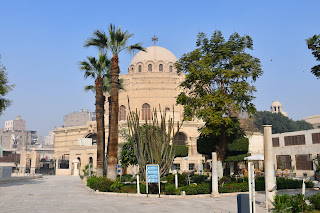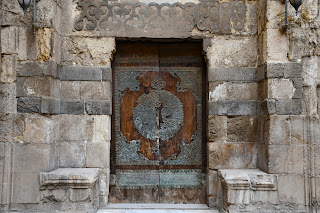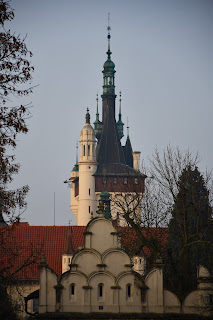An Egyptian Excursion – Day 7: Cairo
I began the day with an Uber ride to the Coptic part of Cairo. As much of this area is pedestrianised, my driver could not take me all the way to the Hanging Church, but he explained that all I needed to do was to walk straight once I had made it past the entrance to the quarter. He seemed quite bemused when I gave him a fifty-pound note for his helpfulness and almost looked as though he hesitated to take the money.
While my
driver’s instructions were clear, I ended up complicating everything by walking
down the first underpass I saw. In effect, there are two main routes in Coptic
Cairo. The first route goes underneath the walls and into the alleyways of the
ancient town. There, signs lead visitors to a cluster of sights, including the
Church of Saints Sergius and Bacchus, the Church of Saint Barbara, and the
Synagogue of Ben Ezra. Of these, only the synagogue was open, since it was a
Sunday morning, and the churches had just begun mass. I had arrived early
enough to be the first person at the Synagogue, and the seller on duty slyly
advised me that – despite all the signs to the contrary – I could take one
picture as long as I avoided being seen by the guard in front of the door. I
gave him fifty pounds for his trouble.
The second
route in Coptic Cairo is on ground level (that is, contemporary ground level)
and follows Mari Gerges Road. To the side of this road is an entrance to the
Greek Orthodox Church of Saint George as well as the church’s expansive
cemetery. Full of huge and impressive family tombs, the cemetery is well worth
a visit. Farther on, the road goes past the Roman Tower and the Coptic Museum,
ending by the Fortress of Babylon and the famous Hanging Church. I entered the
Hanging Church, where no service was underway but plenty of devotees were
streaming through to touch the glass cases of saints embroidered on bright red
pillows. With its roots stretching all the way back to the third century, the
Hanging Church is one of the oldest churches in Egypt.
I found the
Fortress of Babylon closed, so I walked back again to the Coptic Museum. The
building houses a truly impressive collection. The first few exhibitions are
dedicated to some of the major discoveries at abandoned Coptic monasteries,
including their elaborate carvings and niche paintings. I was interested to
learn that Christian monasticism originated in Egypt, where it was pioneered by
Anthony the Great. Further on, the museum exhibits old textiles, metalwork,
woodwork, and paintings, but the piece that elicited an audible gasp from me
were two pages of the apocryphal Gospel of Thomas discovered at Nag Hammadi.
I returned
to the lower level of the Coptic City to find that the service is the Church of
Saints Sergius and Bacchus had finished. The mass at Saint Barbara’s was still
going on, and so – although I had not seen much of the church itself – I
comforted myself that at least I had heard some Coptic, the liturgical language
of the church and a direct descendant of Ancient Egyptian. I then walked out
and caught an autorickshaw off the street, asking the driver to take me to the
Mosque of Ibn Tulun. He initially requested four hundred pounds, and even
though I haggled down to one hundred fifty, I still had the nagging feeling
that I should not be paying one hundred fifty when my long Uber ride cost just
a little over two hundred.
The Mosque
of Ibn Tulun was magnificent. Built in the ninth century, it is one of the
oldest mosques in Egypt and probably the oldest to have retained its original
form so faithfully. Its most interesting feature is its minaret with a spiral
staircase, which can be accessed from the outside. Inside the mosque, the
arches are almost intimidatingly tall; interestingly, one can walk directly
above them by entering from the minaret side, and there is no railing at all to
protect tourists from their own stupidity. I was glad that when I withdrew
money at an ATM in Alexandria yesterday, I received a lot of fifty-pound notes
which I could use for tips. When I wanted to tip the man who put plastic bags
on my shoes, however, he told me without the smallest scruple that fifty pounds
was too little for a donation to a mosque. For the rest of the day though, no
one complained.
It was on
my walk from the Ibn Tulun Mosque that I realised Cairo is a Great City with a
capital G. I kept passing by so many impressive medieval mosques and mausoleums
in various stages of disrepair that I began to understand why none of them were
receiving any visitors. They would have been the star attraction of any other
Middle Eastern city, but here in Cairo, they were just drops in a bucket. With this
thought in my head, I arrived by the Salah El-Deen Square. On one end of the
square (actually a big roundabout) stands the joint complex of the Mosque-Madrasa
of Sultan Hassan and the Al-Rifa’i Mosque. I knew nothing of these buildings
besides the fact that they were huge and beautiful, but upon entering
Al-Rifa’i, I learned that both King Farouk and Mohammad Reza Pahlavi were
buried there.
I was
uncertain about how I would continue to the Cairo Citadel, which I had vaguely
recognised from the previous mosques without being able to ascertain how far
away its entrance might be. It was a particularly hazy day: I put on my face
mask as soon as I left the Coptic Museum and saw how grey everything had
become. Fortunately, I was spotted by an autorickshaw driver and his
English-speaking friend, whom I bartered down to a still exorbitant but
acceptable one hundred pounds. The friend was dropped off on the way, however,
and when the driver brought me to the citadel, he asked for a hundred and
fifty. I protested that this was not what we had agreed upon, he kept insisting
otherwise in Arabic, and our dispute was only ended by a policeman who ruled in
my favour, no doubt out of the belief that all autorickshaw drivers are conmen.
Visiting Cairo’s Citadel is perhaps a half a day activity
for some, as it houses not just a beautiful giant mosque, but also a police
museum and a military museum. I only cared about the mosque and the
fortifications, so I was done relatively quickly, and to my surprise I found my
previous driver’s friend waiting for me with his own autorickshaw. For another
one hundred and fifty pounds, he drove me to the Gate of Zuwayla, marked the
beginning of the last historical neighbourhood I had on my itinerary. Wandering
north, I visited Al-Azhar Mosque, from which I crossed the road to the Khan
el-Khalili, a large open-air bazaar, and finally to the pedestrianized street
of Al-Mu’izz.
Al-Mu’izz is another one of those Cairo streets that houses
more mosques and mausolea than the city’s labour force can maintain. Indeed,
walking through several of them, I often found myself alone in a dilapidated
courtyard or barred by a bolted door. Still, each mosque and mausoleum had a
guard checking the combined ticket, which I bought at the very foot of the
street. Observing other tourists, I found that some off-limits areas were not
strictly off limits if one knew whom to pay to remove an inconvenient padlock,
but by that point I could not fathom who would possibly want to see yet another
room in yet another mausoleum.
Once I left
the walled city through Al-Futuh Gate, I found myself on a busy road. When I first
planned my day, I had thought I would call an Uber to my hotel from a café, but
it soon became painfully evident that none of the cafés in the historical area
were upscale enough to offer Wi-Fi. Nevertheless, I hung around for a while
hoping that my phone might connect to some provider, but I left when people
started approaching me and offering me their services. I walked north towards
the closest metro station I could find, passing through a truly local area with
its strange smells and noises. All around me, people were selling various
vegetables and fish as well as live animals like rabbits, chickens, and
turkeys. These were kept on top of plastic boxes with a little feed, often just
within reach of their skinned brethren.
On my way,
I realised my plan was not a good one. The metro would not take me anywhere
close to my hotel, and I was not sure whether the other stations would be close
to any establishments with Wi-Fi. Therefore,
when I reached the busy intersection and found the station, I did not go in but
looked for a sensible café with outdoor seating. The place I had set my eyes on
from across the road did not have Wi-Fi, and the employees inside ignored me
and my ostentatious inspection of a menu QR code. It had occurred to me that if
I asked to order something using the QR code, the waiter might hotspot me, but no
one paid me any attention.
As I stood
there wondering what to do, a boy went past me and squeaked “Give me five
pounds!” I paid him no attention but by the time he came back the same way, I
had thought of a response. “Give me five pounds!” he said again, and I promptly
answered, “I’ll give you money if you give me internet!” The boy had clearly
not expected this response, but it piqued his interest, and I soon found myself
pointing at my phone icons in an effort to explain that I wanted him to hotspot
me. Fortunately, the boy was bright. He pulled out his phone and after some
fiddling around, I managed to get online.
In the
meantime, the patrons of the café had begun to watch our little troubleshooting
session. It became evident from the boy’s interactions with them that he was
the son of the owner of the café, whose offer of a chair I politely refused as
the Uber I had ordered was not very far away. Still, I waited for around five
minutes, and in the awkward pause that ensued I fished around in my wallet to
give the boy his money. During my entire stay in Egypt, I have never seen
anything smaller than a fifty-pound note, as everyone who deals with tourists
gladly pockets all smaller change. When I offered a fifty-pound note to the
boy, however, his eyes grew large and he stepped back, putting his arm across
his chest and straightening up proudly. I tried putting the note in his hand,
but he put it right back in my backpack as though he could suddenly not even
countenance the thought of receiving the equivalent of one US Dollar.
We had a
faltering conversation in broken English, during which I found out the boy’s
name was Muhammad and he was twelve years old. In exchange, he and his younger
brother (who appeared a little more cupidinous as he kept repeating his
brother’s earlier demand for five pounds) learned I was from Europe. One of the
patrons asked what I was doing in the area, to which I responded that I wanted
to visit the local mosque – a term I had to correct to “masjid” as the former
had not been understood. I could not see the driver when he arrived at the busy
intersection, so the boy offered to call him on my phone. As he opened the door
to the car, even he recognised that he had rendered me an almost invaluable
service, so he did not refuse the fifty-pound note when I offered it to him
again.
One last
note: When I told my mum I had seen Reza Shah Pahlavi’s grave in Cairo,
she responded as she always does when his name comes up in conversation: “He
was very modern, you know. He let women take off their burkas.” Her father, she
said, had once attended a dinner with the Shah when he came to Prague, as he had
helped engineer a dam in Iran. That, at least, is our family lore: I have also
heard her say the same thing about my grandfather and Norodom Sihanouk, from
whom he allegedly received a medal. My grandfather often brought his family
gifts from the countries where he helped implement hydroengineering projects:
My mum was the star of her class for wearing an American-style t-shirt with a
big print that he had brought back from Afghanistan. She said she was sure we
still had crocodile skin handbags from Africa lying around somewhere at our
house.






















































Comments
Post a Comment